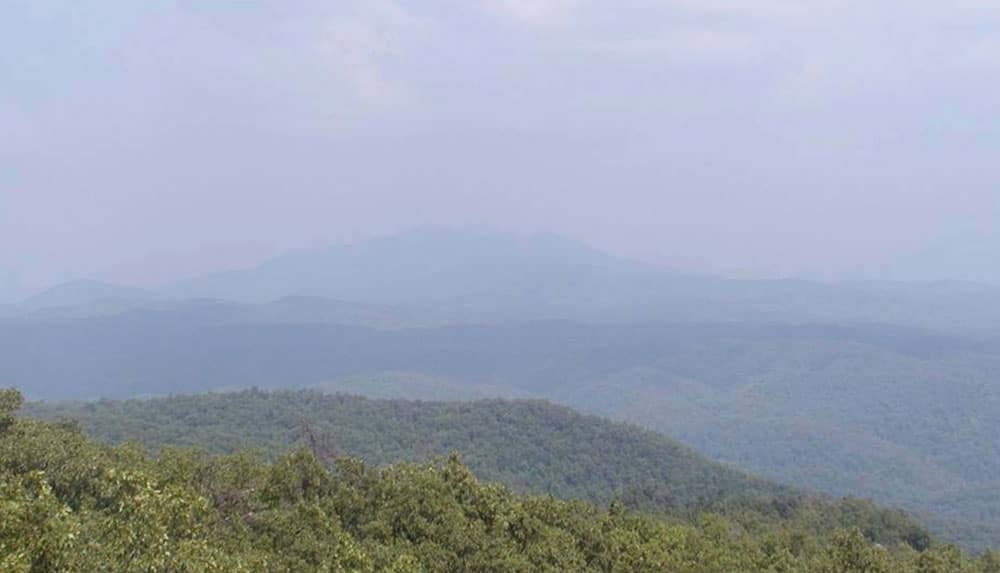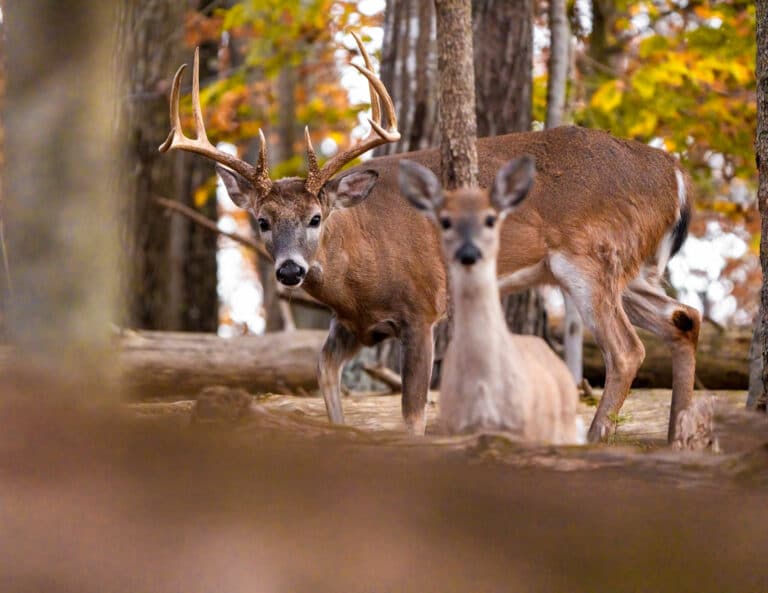Hiking in Smoggy Parks Can Be Hazardous to Your Health
On a dark, moonless night deep in the Smokies, I collided with a bear.
It had started out as a beautiful solo trek along the Appalachian Trail. But on that hot summer day, pollution levels in the park spiked, and a blanket of soot and sulfur dioxide smothered the Smokies.
I hadn’t ever paid attention to air quality forecasts. And this wasn’t downtown L.A. or Atlanta. This was one of the wildest and most remote sections of Great Smoky Mountains National Park. How bad could the air really be?
I found out a few miles south of Clingmans Dome, when I started to wheeze. My chest felt tight and my lungs burned. I was having a pollution-induced asthma attack in the middle of the largest swath of wildlands in Southern Appalachia.
I stumbled for a few more miles, stopping every few yards to kneel and catch my breath. The sun sank behind the mountains. I kept staggering forward, but I soon realized that I wasn’t going to make it back to the trailhead before dark. I didn’t have a phone or a flashlight.
The first stars glimmered in the pale twilight. In my oxygen-starved mind fog, I didn’t know what to do except keep moving forward, tripping over rocks and roots in the dark. My breathing was getting worse, and my throat felt scorched. I could no longer see the trail in front of me. I stumbled and fell into a patch of blueberry bushes—and something else. I could smell the musk of its wet fur.
The bushes erupted. A bear bolted from beneath me and growled. I could only see the whites of its eyes and its furry silhouette. I slowly, slowly, slowly crept back from the bushes. After a few moments, the bear huffed and lumbered away.
I curled up and shivered beside the trail until morning. Pollution levels dropped overnight, and by the first blush of dawn, I was able to breathe again. A few hours later, I made it back to the trailhead.
There were a lot of lessons learned from my misadventure (always carry a flashlight; avoid face-planting into blueberry bushes), but one of the most important was this: air pollution doesn’t respect park boundaries. Sadly, national parks and forests in Southern Appalachia suffer from some of the worst air pollution in the country.
After my pollution-induced asthma attack, doctors equipped me with a spirometer to measure my respiration: on bad air pollution days, my breathing worsened. I have since suffered similar pollution-induced asthma attacks in other parks and public lands across the Southeast. Even in pristine wildlands, there was no escape from the air pollution that is suffocating the entire region. Most of it comes from coal-burning power plants across the region that blanket the Blue Ridge in a toxic stew of soot and smog.
Air pollution is the most deadly and least recognized threat to your health. Globally, it kills seven million people a year—more than twice the number of total deaths from COVID to date. It sickens millions more, especially in marginalized communities. Air pollution is linked to heart attacks, heart failure, cancer, and respiratory disease. Amid a respiratory pandemic, air pollution has become even more deadly. According to a recent Harvard University study, air pollution has increased COVID deaths by 8%, and mortality rates are even higher in communities of color where air pollution is worse.
Air pollution has similar effects as smoking. Even healthy, outdoorsy people running and biking in the forest can be harming their health by exercising on smoggy summer days. And as I discovered the hard way, parks, forests, and public lands often have the worst air pollution. All of the parks in the Southeastern U.S. have air that is unhealthy to breathe at times, especially during the summer when pollution is most intense and dangerous.
Fortunately, the Clean Air Act’s Regional Haze Rule requires states to develop a plan to reduce human-caused air pollution that affects America’s most iconic 48 national parks and 108 wilderness areas, which are known as Class I areas. In North Carolina, there are five Class I areas, including Great Smoky Mountains National Park, Linville Gorge Wilderness Area, and Shining Rock Wilderness Area. Virginia’s Class I areas are Shenandoah National Park and James River Face Wilderness Area. States across the region are revising and finalizing their Regional Haze Rule plans now, which must be submitted to the EPA by July 31, 2021.
Unfortunately, many Southeastern states—including Virginia and North Carolina—are crafting plans that miss critical opportunities to reduce emissions and leave too many industrial pollution sources unchecked. In North Carolina, they are excluding from their plans the largest and dirtiest sources of air pollution: coal-burning power plants. They are also excluding soot and nitrogen oxides, two of the deadliest air pollutants, from their consideration. As a result, North Carolina’s state implementation plan is poised to be a do-nothing plan for public health across the state, as well as for the outdoor industry that relies on clean air in these special places for outdoor recreation. Virginia’s proposed plan is similarly problematic.
These weak air quality plans will continue to place the burden of dirty air on Black and low-income communities who have already been hit hardest by air pollution. These communities suffer from higher rates of asthma, bronchitis, and other respiratory diseases. Virginia and North Carolina have both ignored many haze pollution sources that are in communities where over 20 percent live below the poverty line and the population is over 50 percent people of color.
These weak plans currently hold no hope of ensuring that your next visit to a national park or forest won’t be hazardous to your health. And these plans do nothing to help clear the views from Linville Gorge, Old Rag, and every other Southern Appalachian vista. Our local economies rely on tourists visiting these treasured Class I areas—clean air gains in the past in our region have bolstered our local outdoor industries—and studies show that park visitation drops by 8% when air quality is poor.
Fortunately, the public can demand better air quality plans from each state. This month, North Carolina’s Division of Air Quality will accept public comments on its proposed plan. With enough public input, these plans can be strengthened. Other states are also revising their Regional Haze Rule plans and accepting public comments soon. The next few weeks will determine the next decade of air quality in Southern Appalachia’s wild places and beyond.
You don’t have to be an expert to comment. If you are an air breather, you can fight for your lungs—and everyone else’s. Ensure your state’s haze plan includes the largest and dirtiest sources of air pollution (coal plants) and the deadliest pollutants (soot and nitrous oxide) and requires these and other polluting industrial sources to clean up or shut down.
I stumbled away from my pollution-induced asthma attack in the Smokies—and my run-in with Smoggy the Bear—with only a few scrapes and a cold night alone in the woods. But a silent killer continues to stalk me every day, with every breath. It stalks you, too.
Visit the National Parks Conservation Association website (npca.org/regionalhaze) to comment directly on your state’s Regional Haze Rule plans.
Cover photo courtesy of the National Parks Conservation Association








